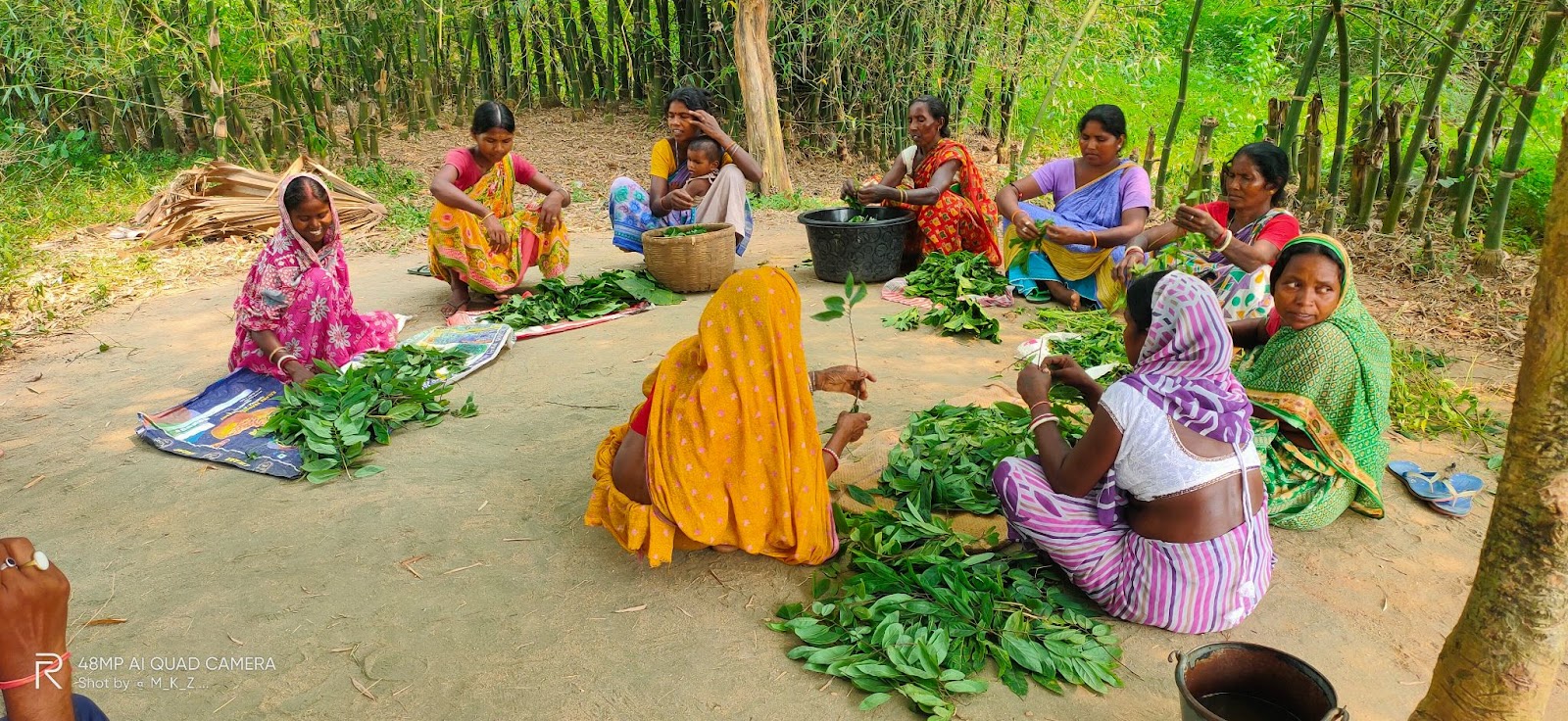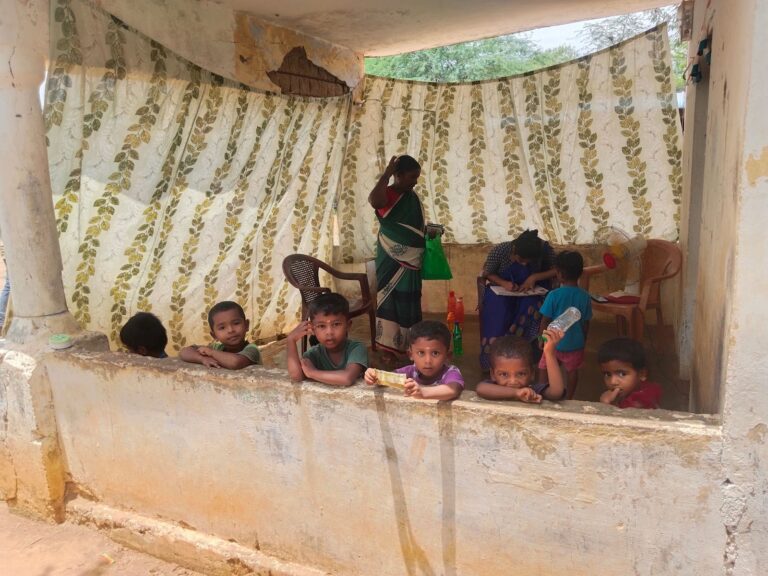Nestled within the mineral-rich state of Jharkhand lies a community in the heart of Jamtara District that has persevered through a myriad of challenges. In a region characterised by small, marginal land holdings and a heavy reliance on rainfall for irrigation, this community has long depended on paddy cultivation during the monsoon season. Despite the abundance of rainfall, lush vegetation, and fertile soil, their agricultural practices remained trapped in a cycle of subsistence farming. With an average landholding size of just 1-2 acres and irrigation coverage barely touching 10% of cultivable land, the community faced profound limitations. However, amidst these adversities, a remarkable transformation has taken root, catalysed by a visionary project. This story unveils the inspiring journey of how this community empowered women, diversified its livelihoods, and built resilience to overcome the challenges that once held them back.
Empowerment of Women:
The impact of empowering women through self-help groups (SHGs) in the beneficiary communities has been nothing short of transformative. These SHGs have not only become active but have also begun to function effectively. Across five blocks, there has been a remarkable 124% growth in the number of SHGs, reflecting the growing participation and commitment of women in these communities. This growth has translated into increased self-confidence among SHG members, both in public and private spaces, empowering them to voice their opinions and actively engage in domestic decision-making processes. The collective power of these women has been harnessed for various purposes, ranging from preventing child marriages to combating domestic violence within the community, and even addressing drainage and transportation issues.
Financial inclusion has been a pivotal aspect of this transformation, resulting in an increase in income through better-performing livelihoods for women. The creditworthiness of SHG members in the intervention area has seen a significant boost, leading to a staggering 245% increase in the number of SHGs linked to banks between 2018 and 2022. This linkage has resulted in a total credit linkage achievement of 7045.8 lakh through 5,636 SHGs, highlighting the financial independence and stability achieved by these women. As a result, members increasingly rely on the group for their monetary needs, underscoring the pivotal role of SHGs in transforming smallholder farmers into agri-entrepreneurs, further contributing to the overall resilience and prosperity of the community.
Picture 1: Activities under SHG
Empowerment of Farmers:
The initiative has not only empowered women but has also significantly improved food security within these communities. Farmers have managed to produce surpluses, allowing them to save more for their personal needs. This achievement has been accompanied by an increase in income per acre for various crops, including paddy, maize, pulses, and vegetables. It’s important to note that this progress occurred despite the stagnation in crop production caused by the COVID-19 pandemic, underscoring the resilience of these farming practices.
Moreover, the program has substantially enhanced the income security of smallholder farmers. The newfound income security has enabled them to invest surplus earnings in areas crucial for community development, such as education and healthcare. Notably, one of the program’s standout achievements has been the establishment of a value chain for paddy seed processing, packaging, and marketing through the ‘Pakur Women Farmer Producer Company,’ further bolstering income generation.
Picture 2 & 3: Paddy nursery work and Pulses grown by farmers
The transition to better farming practices and improved yields has been remarkable. Farmers have shifted from the traditionally followed mono-cropping to multi-cropping, resulting in increased interest and motivation in farming activities. This shift has not only led to better yields but has also diversified the range of products cultivated. Income diversification has become a reality through diverse farm-based activities, significantly boosting farmers’ secondary sources of income. In addition to crop-centric support, the program has extended its benefits to livestock farmers, providing essential care and assistance.
High-value crops have taken center stage, with the introduction and adoption of cash crops such as tomatoes, chili, and brinjal. This strategic move has substantially increased income prospects for farmers. Ensuring timely access to quality seeds through Farmer Producer Organizations (FPOs) has been a critical aspect of this initiative, allowing farmers to optimize their crop cultivation practices. This comprehensive approach to empowerment has not only improved the financial standing of farmers but has also increased the overall resilience of these communities, bringing about a transformation that extends far beyond the fields.
Picture 4 & 5: Training for capsicum nursery and making organic pesticide
Linking the Stakeholders:
Central to the success of this transformative initiative has been the robust linkage of stakeholders and convergence with various government schemes and best practices. The program has exhibited a strong convergence with schemes like MNREGA (Mahatma Gandhi National Rural Employment Guarantee Act), PMAY (Pradhan Mantri Awas Yojana), SBM (Swachh Bharat Mission), ATMA (Agricultural Technology Management Agency), and others. This alignment has been instrumental in channeling resources and support towards the upliftment of the community.
Notably, an impressive INR 10,421.17 lakh has been secured through MNREGA until 2022, with a significant 67% of these funds directed towards Natural Resource Management (NRM) and agriculture. This financial injection has played a pivotal role in enhancing the sustainability and resilience of the local agricultural sector.
The program has also been proactive in adopting best practices from training modules of other non-governmental organizations (NGOs), thereby leveraging the collective knowledge and expertise available in the development sector. Furthermore, a steadfast adherence to the principles set forth by the government’s livelihood mission has ensured that the program aligns seamlessly with broader development goals.
Knowledge dissemination, skill building, and access to credit, marketing, and other livelihood services have been cornerstones of this initiative, enabling upward mobility for the community members. An emphasis on avoiding data duplication and achieving effective collaboration has streamlined operations and maximized the program’s impact.
A noteworthy achievement within this framework has been the establishment of a value chain for paddy seed processing, packaging, and marketing through the ‘Pakur Women Farmer Producer Company.’ This accomplishment has not only enhanced agricultural practices but has also boosted income generation for farmers. Additionally, ensuring the on-time delivery of seeds to farmers through Farmer Producer Organizations (FPOs) has further cemented the program’s commitment to linking stakeholders for the betterment of the community.
Sustainable Solution:
This transformative initiative has introduced sustainable solutions that hold the promise of long-term community resilience. One key aspect of this sustainability drive has been the creation of community-level and individual farm-level assets through land and water resource development, including the construction of ponds and the implementation of other water conservation methods. These endeavors not only enhance agricultural productivity but also bolster the community’s ability to manage water resources effectively, mitigating the impact of erratic rainfall.
Picture 6: Tank preparation for water conservation
The program’s commitment to sustainability is further evident in its embrace of modern innovation while respecting traditional farming wisdom. The adoption of bio-pesticides and fertilizers represents a harmonious convergence of eco-friendly practices and cost-effectiveness, perfectly aligned with the principles of sustainable development goals. This holistic approach ensures that the positive impact of the program extends well into the future, safeguarding the well-being and resilience of these communities for generations to come.
Ensuring Quality:
A hallmark of this transformational initiative has been its unwavering commitment to ensuring quality at every level of operation. This dedication to excellence is particularly evident in the impressive statistic that highlights the progress made within the self-help groups (SHGs). Out of a total of 4,219 SHGs, a substantial 2,852 have advanced to the esteemed Grade A or B. This achievement is a testament to the program’s rigorous standards and its dedication to not only empowering women but also facilitating their growth and development within the SHG framework. The focus on quality assurance resonates throughout the initiative, underlining its determination to deliver meaningful and sustainable change to the communities it serves.
Conclusion:
In the heart of Jharkhand’s Jamtara District, a story of transformation continues to unfold. Women have become pillars of progress, and marginal lands now champion sustainable agriculture, economic empowerment, and resilient communities. This holistic approach to empowerment, sustainability, and quality assurance has not only changed lives but has also ignited a beacon of hope for similar communities facing adversity. It stands as a testament to what can be achieved when empowerment, innovation, and resilience converge to forge a brighter future




